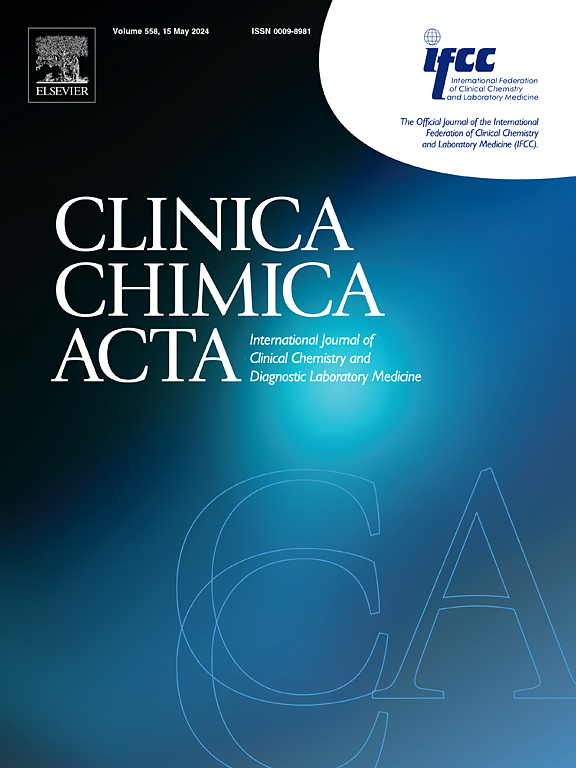Establishment of a high-sensitivity time-resolved fluorescence immunoassay with PLA2R-IgG1 antibody and its clinical application in idiopathic membranous nephropathy prognosis
IF 3.2
3区 医学
Q2 MEDICAL LABORATORY TECHNOLOGY
引用次数: 0
Abstract
Introduction
The objective of this study was to develop a highly sensitive time-resolved fluorescence immunoassay (TRFIA) method to detect phospholipase A2 receptor (PLA2R)-IgG1 antibodies and evaluate its clinical relevance in predicting the prognosis of individuals with idiopathic membranous nephropathy (IMN).
Materials and methods
A three-step indirect TRFIA method was established using a PLA2R antigen-coated microtiter plate to capture PLA2R-IgG antibodies, followed by detection using mouse anti-human IgG1 and Eu3+-labeled goat anti-mouse IgG antibodies. This method was applied to the initial serum of 56 patients with PLA2R-IMN to investigate the clinical value of PLA2R-IgG1 antibody levels in predicting IMN prognosis.
Results
The detection range of PLA2R-IgG1-TRFIA was 0.85–300 RU/mL, with intra-assay precision of 3.54–5.93 % and inter-assay precision of 4.39–9.36 %. Recoveries were 101.77–108.04 %. A PLA2R-IgG1 level above 2.21 RU/mL indicated PLA2R-IMN. At initial diagnosis, the median PLA2R-IgG level was 51.24 RU/mL in the remission group and 93.27 RU/mL in the non-remission group. The median PLA2R-IgG1 level was 603.32 RU/mL in the non-remission group, which was 4.29 times higher than that in the remission group (140.67 RU/mL). PLA2R-IgG1 levels (P = 0.001) more effectively distinguished between remission and non-remission groups compared with PLA2R-IgG levels (P = 0.094).
Conclusions
The first quantitative TRFIA for PLA2R-IgG1 was established, showing greater clinical value in predicting IMN prognosis, compared to that for PLA2R-IgG levels.
利用 PLA2R-IgG1 抗体建立高灵敏度时间分辨荧光免疫测定及其在特发性膜性肾病预后诊断中的临床应用
简介本研究旨在开发一种高灵敏度的时间分辨荧光免疫分析(TRFIA)方法来检测磷脂酶A2受体(PLA2R)-IgG1抗体,并评估其在预测特发性膜性肾病(IMN)患者预后方面的临床意义:使用PLA2R抗原涂层微孔板捕获PLA2R-IgG抗体,然后使用小鼠抗人IgG1和Eu3+标记的山羊抗小鼠IgG抗体进行检测。该方法适用于 56 例 PLA2R-IMN 患者的初始血清,以研究 PLA2R-IgG1 抗体水平在预测 IMN 预后方面的临床价值:PLA2R-IgG1-TRFIA的检测范围为0.85-300RU/mL,测定内精密度为3.54-5.93%,测定间精密度为4.39-9.36%。回收率为 101.77-108.04%。PLA2R-IgG1 水平超过 2.21RU/mL 表示 PLA2R-IMN。初次诊断时,缓解组的 PLA2R-IgG 水平中位数为 51.24Ru/mL,未缓解组为 93.27Ru/mL。未缓解组的 PLA2R-IgG1 水平中位数为 603.32RU/mL,是缓解组(140.67RU/mL)的 4.29 倍。与PLA2R-IgG水平(P = 0.094)相比,PLA2R-IgG1水平(P = 0.001)能更有效地区分缓解组和非缓解组:结论:首次建立了 PLA2R-IgG1 定量 TRFIA,与 PLA2R-IgG 水平相比,它在预测 IMN 预后方面显示出更大的临床价值。
本文章由计算机程序翻译,如有差异,请以英文原文为准。
求助全文
约1分钟内获得全文
求助全文
来源期刊

Clinica Chimica Acta
医学-医学实验技术
CiteScore
10.10
自引率
2.00%
发文量
1268
审稿时长
23 days
期刊介绍:
The Official Journal of the International Federation of Clinical Chemistry and Laboratory Medicine (IFCC)
Clinica Chimica Acta is a high-quality journal which publishes original Research Communications in the field of clinical chemistry and laboratory medicine, defined as the diagnostic application of chemistry, biochemistry, immunochemistry, biochemical aspects of hematology, toxicology, and molecular biology to the study of human disease in body fluids and cells.
The objective of the journal is to publish novel information leading to a better understanding of biological mechanisms of human diseases, their prevention, diagnosis, and patient management. Reports of an applied clinical character are also welcome. Papers concerned with normal metabolic processes or with constituents of normal cells or body fluids, such as reports of experimental or clinical studies in animals, are only considered when they are clearly and directly relevant to human disease. Evaluation of commercial products have a low priority for publication, unless they are novel or represent a technological breakthrough. Studies dealing with effects of drugs and natural products and studies dealing with the redox status in various diseases are not within the journal''s scope. Development and evaluation of novel analytical methodologies where applicable to diagnostic clinical chemistry and laboratory medicine, including point-of-care testing, and topics on laboratory management and informatics will also be considered. Studies focused on emerging diagnostic technologies and (big) data analysis procedures including digitalization, mobile Health, and artificial Intelligence applied to Laboratory Medicine are also of interest.
 求助内容:
求助内容: 应助结果提醒方式:
应助结果提醒方式:


